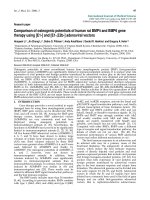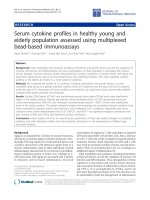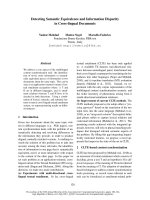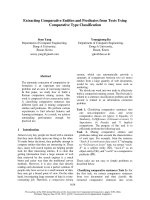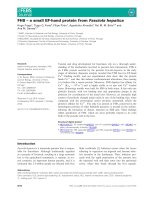Detecting Fasciola hepatica and F. gigantica microRNAs using loop-mediated isothermal amplification (LAMP)
Bạn đang xem bản rút gọn của tài liệu. Xem và tải ngay bản đầy đủ của tài liệu tại đây (848.24 KB, 6 trang )
Tạp chí Khoa học & Công nghệ Số 5
6
Detecting Fasciola hepatica and F. gigantica microRNAs
using loop-mediated isothermal amplification (LAMP)
Tran Hong Diem, Phung Thi Thu Huong*
Nguyen Tat Thanh Hi-Tech Institute, Nguyen Tat Thanh University
*
,
Abstract
Fascioliasis is a parasitic infection typically caused by two common parasites of class
Trematodo, genus Fasciola, named Fasciola hepatica and F. gigantica. The widespread
appearance of these species in water and food makes fascioliasis become a global zoonotic
disease that affects 2.4 million people in more than 75 countries worldwide. Typically, F.
hepatica and F. gigantica can be recognized with parasitological techniques to detect Fasciola
spp. eggs, immunological techniques to detect worm-specific antibodies, or molecular
techniques for instance polymerase chain reactions to detect parasitic genomic DNA. Recently,
miRNAs have been recognised a key regulator and potential diagnostic biomarkers of diseases,
including parasitic infection. An isothermal PCR called LAMP (loop-mediated isothermal
amplification) is rapid, sensitive, and this amplification is very extensive, making it well-suited
for field diagnostics. LAMP reaction for miRNA detection has been introduced and is able to
detect miRNA in the range between 1.0amol and 1.0pmol, showing high selectivity to
differentiate one miRNA sequence from others. Here, we introduced a modified LAMP to
detect a typical miRNA of both F. hepatica and F. gigantica. Our method does not demand an
initial heating step and the reactions have a high sensitivity even 1,000 times higher in
comparison to that reported in previous studies. These results create a promising technique basis
for some novel and simple device to diagnose fascioliasis and other parasitic diseases at pointof-care.
® 2019 Journal of Science and Technology - NTTU
1 Introduction
Fascioliasis, a parasitic infection, is one of the major
neglected tropical diseases caused by flatworms Fasciola
hepatica and F. gigantica, two species of trematodes that
mainly affect the liver. They are also known as “the
common liver fluke”[1]. Fascioliasis is waterborne and
foodborne zoonotic disease in which human are incidental
hosts and get infected by consuming contaminated
watercress or water[1-3]. This disease is found in all five
continents, in over 75 countries and infects at least 2.4
million people worldwide[4]. As the result, fascioliasis
diagnostic methods have always been of interest and on
improvement. Normally, the infection confirmation is
abided by different ways of diagnostic techniques. The
typical criteria to confidently confirm a person is infected
with Fasciola spp. is by observing the parasite[2]. This
Đại học Nguyễn Tất Thành
Nhận
09.10.2018
ược duyệt 25.02.2019
Công bố
26.03.2019
Keywords
fascioliasis, LAMP,
miRNA.
parasitological technique is set up to find Fasciola spp.
eggs in feces specimens[2]. However, it can be hard to
search for eggs in stool specimens from patients with light
infections. Thus, the infection has to be diagnosed by
alternative methods rather than by examining stool
samples[2]. Specific and sensitive molecular diagnostic
methods, including polymerase chain reactions (PCR),
enzyme-linked immunoelectrotransfer blot (EITB), and
enzyme-linked immunosorbent assay (ELISA), have been
developed for fascioliasis[2,4]. However, these tests require
advanced skills and equipment that is not available in
resource-limited settings, especially in isolated areas where
the disease is widespread.
Recently, the discovery of microRNAs (miRNAs), a short
non-coding RNA molecular that has about 21-25
nucleotides of length in eukaryote cells, has expanded our
understanding of the pathogens‟ mechanisms[5], and has
Tạp chí Khoa học & Công nghệ Số 5
created new changes for developing novel techniques to
detect them. Clearly, miRNAs play a pivotal role in
regulating pathogen gene expressions with a variety of
manners[5-8]. The presence of miRNAs in serum has been
proven to be an important biomarker for the diagnosis of
certain diseases such as viral infections, cardiovascular and
nervous system disorders, and diabetes[5]. The interest in
the role of small RNAs in parasitic infections has been
rapidly growing currently. Importantly, miRNAs are
identified as one of the key regulators in nematode
development[9]. Parasitic circulating miRNAs has been
shown to be detected in the biological fluids of infected
hosts, such as serum, saliva and others[10-15].
The extreme stability of the secret miRNAs is believed to
be due to their release within micro-vesicles or exosomes or
by forming complex with special protein[13]. Studies on
Heligmosomoides polygyrus‟s excreted materials have
proved that certain miRNAs excreted by parasites are
covered in the extracellular vesicles[17]. Moreover, those
parasitic miRNAs in the exosomes are also transported to
host cells[17]. Exosome-like vesicles containing miRNAs
are reported to be released from the infective L3 stage of
the human filarial parasite Brugia malayi[18]. Importantly,
release of exosomes derived from F. hepatica has also been
demonstrated[19]. Despite the fact that there was no
mutuality between the microfilariae number and miRNA
quantity[20], the gathered information significantly
demonstrates that the particular parasitic miRNAs present
in the host circulatory system advantagedly appear as noninvasive markers for the detection of specific infections.
Furthermore, the detailed profiles of miRNAs expression of
parasitic helminthes have recently been created, including
fluke, nematodes, and tapeworms such as F. gigantica and
F. hepatica[21, 22]. The reseach reports the comparison of
miRNA expression profiles of F. gigantica and F. hepatica
and shows that there are 11 miRNAs shared by the two
kinds of worm, including 8 conserved and 3 novel
miRNAs[22]. All the conserved miRNAs are the same as
those from Schistosoma japonicum in the miRBase
database. Besides, 8 and 5 miRNAs were identified as F.
gigantica- and F. hepatica-specific, respectively[22].
detecting miRNAs is challenging because they are short
and highly homologous[23]. Different methods for
detection of miRNAs have been developed including
northern[24], reverse transcription PCR (RT-PCR)[12],
microarrays and others; however, each method has its
particular restrictions. Currently, different detection
methods have been produced, such as isothermal
exponential amplification-based methods, cleavage-based
methods, rolling cycle amplification-based methods,
AuNPs-based methods, quantum dot-based methods,
capillary-electrophoresis-based assay[25]. A shared idea
7
between these recently created methods is the combination
of multistep signal enhancement and sensitive signal
detection to accomplish great recognitive efficiency. A
loop-mediated isothermal amplification (LAMP) to detect
specific miRNA has recently been introduced[25] (Fig. 1).
LAMP can be accomplished with only one kind of DNA
polymerase without requirement of any modified or labeled
DNA probes to markedly decrease the cost and make the
experimental
procedure
simpler.
A
conceivable
disadvantage of the LAMP is the need of a template DNA,
forward inner primer (FIP), backward inner primer (BIP),
and backward outer primer B3[26]. However, LAMP
reactions merely need little amount of primers and
template, making this assay still cost-effective. Moreover,
LAMP was demonstrated to be able to detect the target
miRNA amounts in the range from 1.0amol to 1.0pmol,
and shows marked selectivity to distinctly distinguish onebase difference among miRNA sequences [26]. However,
LAMP reactions merely need little amount of primers and
template, making this assay still cost-effective. Moreover,
LAMP was demonstrated to be able to detect the target
miRNA amounts in the wide range of 1.0amol to 1.0pmol,
and displayed marked selectivity to distinctly distinguish
one-base difference among miRNA sequences [26]. In this
study, we have developed a modified LAMP method to
sensitively and accurately detect the miRNA speciesspecific for Fasciola spp. By using this technique we
achieved to detect specific miRNA of F. hepatica and F.
gigantica at the amount of 1zmol in short time and simpler
process at a constant temperature.
Figure 1 LAMP reaction initiated by the target miRNA (adopted
from[26]). All the sequences of the DNA template, FIP primer,
BIP primer, B3 primer and parasite miRNA are listed in Table 1.
Đại học Nguyễn Tất Thành
Tạp chí Khoa học & Công nghệ Số 5
8
2
Materials and Methods
2.1 Nucleotides, enzymes, and chemicals
The oligonucleotides used to perform LAMP reactions were
synthesized commercially from IDT (Skokie, Illinois,
USA). Isothermal Master Mix was purchased from
OptiGene (Horsham, West Sussex, UK). Bovine serum was
obtained from Sigma-Aldrich (St. Louis, Missouri, USA).
Nucleic acid gel stain GelRed was provided by Biotium
(Fremont, CA, USA).
2.2 The LAMP reaction
The LAMP reaction consisted of FIP, BIP, and B3 primers
that were designed like previous[26]. The template was also
inherited from the previous study[26] with a sequence
modification which was complementary to the selected
parasite miRNA. The RNA oligo which mimics the parasite
miRNA was selected from the previous finding[22]. The
oligonucleotides used to perform LAMP reactions are listed
in Table 1. LAMP were performed in a reaction mixture
(15µl) containing the indicated amount of miRNA and
template, 6pmol of FIP and BIP, 0.5fmol of B3[26] and 9µl
of Isothermal Master Mix. Reactions were incubated at
60°C for 90 minutes (min). The LAMP products were then
subjected to 1.5% agarose gel electrophoresis, and
visualized by staining with GelRed and photographied
under UV light.
3
Results
3.1 Selection of the species-specific miRNA of Fasciola
spp. and designation of the LAMP reaction components
Based on the study establishing the miRNA expression
profiles of F. gigantica and F. hepatica using an combined
sequencing with bioinformatics approach and quantitative
real-time PCR[22], the sequence of one Fasciola spp.-novel
miRNA sharing between two kinds of worms was selected
to serve as the biomarker for Fasciola spp. detection
employing LAMP (Table 1). Also, we followed the LAMP
components that were designed previously to conduct the
LAMP reactions initiated by miRNAs[26].
Table 1 Oligonucleotides designed for LAMP reactions
3.2 Performance of LAMP with synthetic miRNA
In this study, we used the synthetic RNA oligo to serve as
miRNA specific for Fasciola spp. (Table 1). LAMP master
mix was commercially provided by OptiGene (Horsham,
West Sussex, UK). The LAMP reaction included 0.5 fmol
of double-stranded (ds) DNA template, 6.0pmol of FIP and
BIP primers, and 0.5fmol of B3 primer[26]. The amount of
Figure 2
The performance of
LAMP with synthetic
miRNA. Reaction
mixture (15µl) contained
10fmol of miRNA,
0.5fmol of ds DNA
template, 6pmol of FIP
and BIP, 0.5fmol of B3
and 9µl of Isothermal
Master Mix. Reactions
were incubated at 60°C
for 90min.
Đại học Nguyễn Tất Thành
synthetic miRNA used was 10fmol. Reactions were
performed at 60°C for 90min. The results show that only in
the presence of miRNA, LAMP product of different size
segments formed a long smear when analyzed on gel
electrophoresis (Fig. 2 lane 1). As expected, when miRNA
was absent, the product cannot be observed (Fig. 2. lane 2).
These data prove that positive signal of the LAMP reaction
specifically corresponds to the presence of miRNA in the
sample.
3.3 The LAMP reactions with double-stranded and singlestranded DNA templates
Although the LAMP reactions to detect the presence of
specific miRNA was performed efficiently as reported
previously, the use of ds DNA template required the need
of a first heating step for a period of two to four minutes
at 96 – 98°C to split the two circuits of DNA. LAMP
utilizes only one enzyme Bst DNA polymerase which also
possesses RNA polymerase (using a DNA template) and
strands displacement activities. Hence, it is expected that
Tạp chí Khoa học & Công nghệ Số 5
without the pre-heating step, the LAMP reactions should
still occur. However, we found that using ds DNA template
without heating first, the reaction cannot succeed (data not
shown). Accordingly, this step leads to the conduct of
experiments more complex and may be a constraint to
future technical development at field study. With the aim of
producing a simpler reaction preparation process, we
utilized a single-stranded (ss) DNA template instead of the
ds one. To prove that this modification does not affect the
LAMP efficiency, the LAMP reactions were performed
with two forms of DNA template and revealed that the
efficiency of reactions is similar between two types of DNA
template used (Fig. 3). Importantly, by using ss DNA
template, the LAMP reactions could occur without the
requirment of heat-up step which can interfere with the
activity of other components in the reactions due to high
temperature. Taken together, we demonstrated that the
modification of using ss DNA instead of ds DNA template
in the LAMP reactions led to the similar results with a
marked advantage of the removal of the pre-heating step,
enabling reaction preparation less complicated and quicker.
Figure 3 The LAMP reactions with different concentrations of
ds and ss DNA templates. The eeaction mixtures contain the
indicated amount of ds and ss DNA template, 10fmol of
miRNA, 6pmol of FIP and BIP, 0.5fmol of B3 and 9µl of
Isothermal Master Mix.
3.4 Sensitivity of the LAMP reactions using single-stranded
DNA template
The LAMP sensitivity is one of the most important factors
which decide the success of the method and its possible
applicability in field study. As mentioned above, LAMP
utilizing ds DNA template was shown to be capable of
identifying the target miRNA in the ultrasensitive range of
1amol to 1pmol[26]. In our hand, the results were revealed
the same where ds-DNA-template LAMP reactions were
succeeded at the lowest amount of 1amol of synthetic
miRNA (Fig. 4, lanes 2 to 5). Markedly, the modified
LAMP reactions with ss DNA template perform efficiently
at the significant lower amount of miRNA, up to 1zmol
(Fig. 4, lanes 7 to 10). These data strongly prove the
superiority of ss DNA template given in our design in
9
comparison to the previous one[26] regarding the
complexity of reaction preparation, time, and sensitivity.
Figure 4 The sensitivity of LAMP reaction to miRNA
amount. Reaction mixture contained the indicated amount of
miRNA, 1fmol of ss DNA template, 6pmol of FIP and BIP,
0.5fmol of B3 and 9µl of Isothermal Master Mix.
4 Discussion
Today, one of the most important missions in managing and
monitoring of neglected tropical diseases is to produce
highly sensitive and proper diagnostic methods which can
replace the laborious and undependable procedures.
Specific and sensitive techniques to detect the early stages
of Fasciola spp. infections can preclude irreversible
pathological reactions, helping monitor and likely directing
the basis for treatment failures. Fasciolosis is often popular
in low-resource regions without proper laboratory
equipment, thus, low-cost methods for practical diagnostics
that do not need centralized laboratories are significantly
required. Accordingly, researching new biomarkers for fast
and accurately detecting the pathogen is highly demanded,
and that can create new simpler and more appropriate
techniques to diagnose diseases.
The LAMP method was used to detect miRNA in previous
studied[26]; however, the results show some technical
limitations. One of the biggest restraints is the need for an
initial heating step at high temperatures to separate the two
circuits of the ds DNA template. The heat-up step can affect
the enzyme activities as well as the other reaction
components. Also, this step makes reactions preparation
and control became more difficult. In our study, we
changed the ds DNA to ss DNA template and hence, the
reactions can occur without the initial heat-up step. The
ability to allow LAMP reactions to be assembled at room
temperature and initiated at only one constant temperature
can offer an excellent advantage in resource-limited
settings. Furthermore, our LAMP reactions also provide the
high level of sensitivity required for diagnosis. When
investigating a limited range of detectable miRNA levels,
Đại học Nguyễn Tất Thành
Tạp chí Khoa học & Công nghệ Số 5
10
we succeeded in detecting as low as 1zmol of the targeted
miRNA. Compared with the previous report in which the
minimum miRNA level detected was 1amol[26], our results
demonstrated that the sensitivity of modified LAMP was
1,000 times higher. This remarkable improvement in
sensitivity significantly increases the probability and
applicability of this method in real life.
Conflict of Interest
The authors declare that there is no conflict of interest.
References
1. World Health Organization. Fascioliasis [cited 2017 13 Nov ]. Available from:
/>2. World Health Organization. Fascioliasis diagnosis, treatment and control strategy [cited 2017 13 Nov]. Available from:
/>3. World Health Organization. Fascioliasis epidemiology
[cited 2017 13 Nov].
/>
Available
from:
4. Tolan RW Jr. MD. Fascioliasis Due to Fasciola hepatica and Fasciola gigantica Infection: An Update on This „Neglected‟
Neglected Tropical Disease. Lab Med. 2011 [cited 2017 14 Nov]; 42(2):[107-16 pp.]. Available from:
/>5. Schultz NA, Dehlendorff C, Jensen BV, Bjerregaard JK, Nielsen KR, Bojesen SE, et al. MicroRNA biomarkers in whole
blood for detection of pancreatic cancer. Jama. 2014;311(4):392-404.
6. Patnaik SK, Kannisto ED, Mallick R, Vachani A, Yendamuri S. Whole blood microRNA expression may not be useful for
screening non-small cell lung cancer. PloS one. 2017;12(7):e0181926.
7. Xin L, Gao J, Wang D, Lin JH, Liao Z, Ji JT, et al. Novel blood-based microRNA biomarker panel for early diagnosis of
chronic pancreatitis. Scientific reports. 2017;7:40019.
8. Yyusnita, Norsiah, Zakiah I, Chang KM, Purushotaman VS, Zubaidah Z, et al. MicroRNA (miRNA) expression profiling
of peripheral blood samples in multiple myeloma patients using microarray. The Malaysian journal of pathology.
2012;34(2):133-43.
9. Brase JC, Wuttig D, Kuner R, Sultmann H. Serum microRNAs as non-invasive biomarkers for cancer. Molecular cancer.
2010;9:306.
10. Cai P, Gobert GN, McManus DP. MicroRNAs in Parasitic Helminthiases: Current Status and Future Perspectives.
Trends in parasitology. 2016;32(1):71-86.
11. Cai P, Gobert GN, You H, Duke M, McManus DP. Circulating miRNAs: Potential Novel Biomarkers for
Hepatopathology Progression and Diagnosis of Schistosomiasis Japonica in Two Murine Models. PLoS neglected tropical
diseases. 2015;9(7):e0003965.
12. Chen C, Ridzon DA, Broomer AJ, Zhou Z, Lee DH, Nguyen JT, et al. Real-time quantification of microRNAs by stemloop RT-PCR. Nucleic Acids Res. 2005;33(20):e179.
13. Hoy AM, Lundie RJ, Ivens A, Quintana JF, Nausch N, Forster T, et al. Parasite-derived microRNAs in host serum as
novel biomarkers of helminth infection. PLoS neglected tropical diseases. 2014;8(2):e2701.
14. Mar-Aguilar F, Trevino V, Salinas-Hernandez JE, Tamez-Guerrero MM, Barron-Gonzalez MP, Morales-Rubio E, et al.
Identification and characterization of microRNAs from Entamoeba histolytica HM1-IMSS. PloS one. 2013;8(7):e68202.
15. Holz A, Streit A. Gain and Loss of Small RNA Classes-Characterization of Small RNAs in the Parasitic Nematode
Family Strongyloididae. Genome biology and evolution. 2017;9(10):2826-43.
16. Britton C, Winter AD, Marks ND, Gu H, McNeilly TN, Gillan V, et al. Application of small RNA technology for
improved control of parasitic helminths. Veterinary parasitology. 2015;212(1-2):47-53.
Đại học Nguyễn Tất Thành
Tạp chí Khoa học & Công nghệ Số 5
11
17. Buck AH, Coakley G, Simbari F, McSorley HJ, Quintana JF, Le Bihan T, et al. Exosomes secreted by nematode
parasites transfer small RNAs to mammalian cells and modulate innate immunity. Nature communications. 2014;5:5488.
18. Zamanian M, Fraser LM, Agbedanu PN, Harischandra H, Moorhead AR, Day TA, et al. Release of Small RNAcontaining Exosome-like Vesicles from the Human Filarial Parasite Brugia malayi. PLoS neglected tropical diseases.
2015;9(9):e0004069.
19. Marcilla A, Trelis M, Cortes A, Sotillo J, Cantalapiedra F, Minguez MT, et al. Extracellular vesicles from parasitic
helminths contain specific excretory/secretory proteins and are internalized in intestinal host cells. PloS one.
2012;7(9):e45974.
20. Tritten L, Burkman E, Moorhead A, Satti M, Geary J, Mackenzie C, et al. Detection of circulating parasite-derived
microRNAs in filarial infections. PLoS neglected tropical diseases. 2014;8(7):e2971.
21. Britton C, Winter AD, Gillan V, Devaney E. microRNAs of parasitic helminths - Identification, characterization and
potential as drug targets. International journal for parasitology Drugs and drug resistance. 2014;4(2):85-94.
22. Xu MJ, Ai L, Fu JH, Nisbet AJ, Liu QY, Chen MX, et al. Comparative characterization of microRNAs from the liver
flukes Fasciola gigantica and F. hepatica. PloS one. 2012;7(12):e53387.
23. Leshkowitz D, Horn-Saban S, Parmet Y, Feldmesser E. Differences in microRNA detection levels are technology and
sequence dependent. Rna. 2013;19(4):527-38.
24. Valoczi A, Hornyik C, Varga N, Burgyan J, Kauppinen S, Havelda Z. Sensitive and specific detection of microRNAs by
northern blot analysis using LNA-modified oligonucleotide probes. Nucleic Acids Res. 2004;32(22):e175.
25. Tian T, Wang J, Zhou X. A review: microRNA detection methods. Organic & biomolecular chemistry. 2015;13(8):222638.
26. Li C, Li Z, Jia H, Yan J. One-step ultrasensitive detection of microRNAs with loop-mediated isothermal amplification
(LAMP). Chem Commun (Camb). 2011;47(9):2595-7.
Phát hiện microRNA của sán lá gan bằng phương pháp
khuếch đại đẳng nhiệt trung gian vòng lặp (LAMP)
Trần Hồng Di m, Phùng Thị Thu Hường*
Viện Kĩ thuật Công nghệ cao Nguy n Tất Thành
*
,
i học Nguy n Tất Thành
Tóm tắt Sán lá gan lớn là một bệnh phổ biến gây ra bởi hai lo i ký sinh trùng thuộc lớp Trematodo, chi Fasciola, là Fasciola
hepatica và F. gigantica. Sự có mặt rộng rãi của hai loài này trong nước và thực phẩm làm cho bệnh sán lá gan lớn trở thành
một trong nh ng bệnh truyền nhi m từ động vật sang người phổ biến nhất, ảnh hưởng đến 2,4 triệu người thuộc hơn 75 quốc
gia trên thế giới. Th ng thường, Fasciola hepatica và F. gigantica có thể được phát hiện bằng các phương pháp mi n dịch
(phát hiện kháng thể đặc hiệu của kí sinh trùng), kĩ thuật kí sinh trùng để phát hiện trứng sán, hay sử dụng kĩ thuật sinh học
phân tử để phát hiện DNA đặc trưng của kí sinh. Trong thời gian gần đ y miRNA đã được nghiên cứu công nhận là dấu
chứng chẩn đoán sinh học nhiều tiềm năng đối với các bệnh, trong đó có các bệnh gây ra bởi kí sinh trùng. Mặt khác,
phương pháp khuếch đ i đẳng nhiệt trung gian vòng lặp – LAMP là một phương pháp khuếch đ i nhanh nh y ở một nhiệt độ
cố định. Với giới h n phát hiện lớn, LAMP trở thành phương pháp phù hợp cho chuẩn đoán nhanh t i vùng nhi m. Kĩ thuật
LAMP đã được chứng minh có khả năng phát hiện miRNA mục tiêu trong ph m vi từ 1amol đến 1pmol. Nghiên cứu này
giới thiệu kĩ thuật LAMP được sửa đổi để phát hiện một lo i miRNA đặc trưng cho cả hai loài Fasciola hepatica và F.
gigantica. Phương pháp này kh ng yêu cầu bước gia nhiệt ban đầu và có độ nh y gấp 1.000 lần so với các nghiên cứu trước
đó. Kết quả này t o nên tiền đề quan trọng cho việc phát triển các thiết bị kĩ thuật mới, đơn giản, nhanh, t i chỗ cho chuẩn
đoán bệnh sán lá gan cũng như các bệnh nhi m kí sinh trùng khác.
Từ khóa sán lá gan lớn, LAMP, miRNA
Đại học Nguyễn Tất Thành
